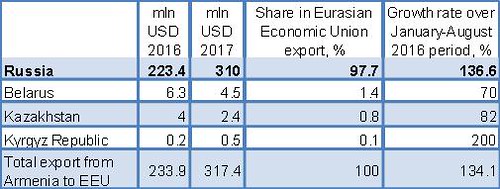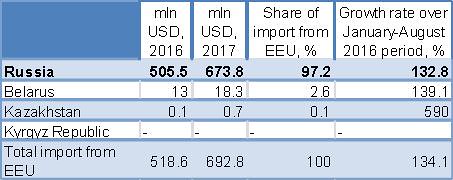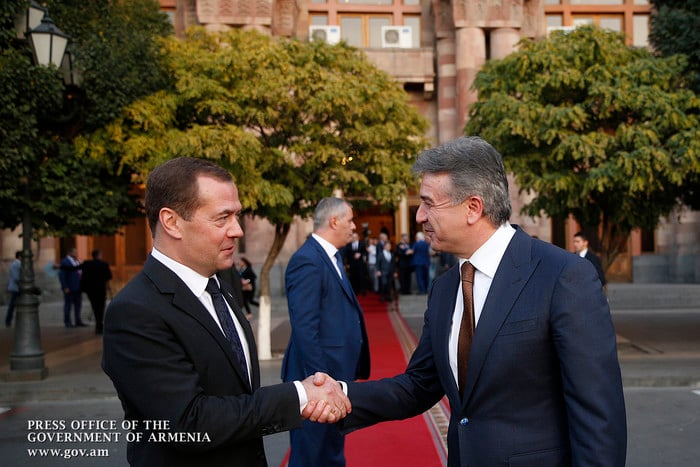At a joint press conference on October 24, Russia’s and Armenia’s prime ministers gave different statistics on the two countries’ trade turnover.
According to Armenian Prime Minister Karen Karapetyan, trade between the two countries in the first eight months of 2017 increased by 23.5%. According to Russian Prime Minister Dmitry Medvedev, that figure is 30%.
Let’s try to figure out the truth, relying on official data.
Armenian National Statistical Service data
According to Armenia’s National Statistical Service (NSS), trade between Armenia and Russia between January and August 2017 comprised US$991.7 million, of which US$310 million was the export of goods from Armenia to Russia and US$681.7 million, the import.
The comparison between 2016 and 2017 figures, based on the NSS data, is shown in Figure 1.

To get a more complete picture, Figure 2 provides a break down of the components of the data.

And so, Armenia’s statistics confirm Karapetyan’s figure, Armenia-Russia trade between January and August 2017 increased by 23.5%, in which export increased by 36.6% and import by 18.3%.
Now let’s go to Russia and study its statistical data.
Federal State Statistics Service of Russia
According to Russia’s Federal State Statistics Service (FSSS), between January and August 2017, Russia’s trade turnover was US$365.2 billion, of which US$973 million was with Armenia, an increase of 28.4% compared to the same period in 2016 (in 2016, this figure was US$758 million).
Recall that for January–August 2017, Armenia’s NSS data for trade with Russia was US$991.7 million. Russia’s FSSS data for this indicator was US$973 million.
The difference is about US$19 million (or 2%).
Interestingly, the data for the corresponding period in 2016 also varies; in particular, according to Russia’s data, trade with Armenia comprised US$758 million, while, according to Armenia’s NSS, this figure was US$803.2 million.
The difference is about US$45 million (or more than 5%).
As we can see, Armenia’s statistics always presents trade with Russia in bigger numbers than Russia does.
Understandably, Armenia plays a minor role in Russia’s export, while from the perspective of our economic and statistical picture, Russia’s role is incomparably greater.
For example, a several-million-dollar increase in export with Russia can substantially change the real picture of Armenia’s economy; meanwhile, such an “exercise” by and large will have a slight impact on Russia’s economy.
It’s easy to notice that such differences in percentage, 2% in 2017 and 5% in 2016, prove that they are not the result of methodological differences.
Clearly, even Russia’s official statistics don’t confirm Medvedev’s claim of a 30% increase; meanwhile, Karapetyan’s numbers are seen in the NSS data. But as we see, a statistical problem exists.
It was interesting to examine also the Eurasian Economic Union (EAEU) economic committee’s data on Armenia-Russia trade; even more so that the two entities present the data with EAEU classifications.
EAEU statistical data analysis
According to statistical data published on October 25, 2017, on the EAEU economic committee’s official website, between January and August 2017 trade between EAEU countries comprised US$34.2 billion — an increase of 27.5% from the same period in 2016.
In Figure 3, we tried to study Armenia’s trade within the scope of the EAEU.

As we see, according to EAEU data, export from Armenia to Russia rose by 36.6% compared to the previous year. It’s noteworthy that also in this regard Armenia’s NSS data corresponds to the EAEU data.
We present the other component of trade — import (Figure 4).

As we can see, the import data differs from the NSS data by 1% (according to the NSS, the January–August 2017 import comprised US$681.7 million).
For the period in question, according to the EAEU data (Figures 3 and 4), Armenia’s trade with Russia in January–August 2017 was US$983.8 million ($673.8 million + $310 million), while for the same period in 2016, it was US$729 million ($505.5 million + $223.4 million).
That is to say, according to the EAEU data, Armenia’s trade turnover with Russia grew by 35%.
To summarize, despite the deviations, Karapetyan’s data seem closer to the reality since, for example, the NSS export figure corresponds to the EAEU number, and the difference in import figures is not significant.
Taking into account that the measuring unit was the US dollar, the data was formed from the same sources and classified on the same basis.
And it’s incomprehensible how the three entities’ (Armenia’s NSS, Russia’s FSSS, and the EAEU) figures so substantially varied from one other on the same indicator.
Such differences deepen doubts about the reliability of statistical data.
For journalists
Writing this article, I used the following official sources:
- NSS data, pp. 78–80.
- Information posted on the official website served as grounds for the Russian data.
- EAEU data; in particular, the data presented in the analytical reports published on October 25, 2016 and 2017.
Artak Manukyan
Economist






